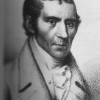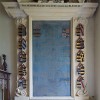Lying as if bracketed by two rivers, The Piddle (Trent) on the north and the Frome on the south, Wareham’s strategic importance was realised from very early times. Finds recovered from excavations under the town’s walls proved there had been some settlement on the site during the Iron Age and Romano-British periods, though it is the Saxons we have to thank for the foundation of Wareham as a planned town (burh). Even so, it was s stronghold resisting the Saxon incursions for two and a half centuries after the Romans left.
Sometime in the 8th century victorious Saxons claimed the site and fortified it with an earthen wall on the north, west and east sides. Christianised, they made their burh a centre of the British faith, having links with the church in Gaul. St. Aldhelm, later to become Bishop of Sherborne visited Wareham to unify the Roman and Celtic traditions.
It is Aldhelm who is believed responsible for the founding, near the north gate in about 698, of St. Martin’’ Church. The original building is supposed to be the burial place of the West Saxon King Beorthric in 802, but the earliest fabric of the present building dates from about 1020. The church is worth a visit to see the remains of Norman and later paintings on its walls, and the characteristically Saxon high and narrow proportions of the building. After 1736 the church was only in use for baptisms and marriages, and was restored in 1935. A miracle legend holds that after the Danes destroyed the roof in a raid, shepherds could still shelter within the walls without getting wet. St. Martins is also famous for a recumbent effigy of Lawrence of Arabia by Eric Kennington.
By reason of its strategic importance the Dane Guthrum captured Wareham in 876, but in the following year King Alfred routed the Danes in a sea battle off Swanage and strengthened the town’s defences. Alfred’s daughter Ethelfleda is said to have restored the Priory after Guthrum had sacked it in 876. Later King Athelstan founded a mint and granted Wareham a market, ruling that all trade must take place within the burh. Towards the end of the 10th century Wareham was assailed by the Danes Sweyn and Cnut (Canute).
Following their own conquest the Normans made the Priory a Benedictine cell of Lire Abbey, and undertook extensive rebuilding in stone around 1100, including strengthening the town’s walls and building a motte and bailey castle. The castle was raided by the army of King Stephen, an event which caused Wareham to be caught in the cross-fire between the king and Matilda, whom the town supported. Stephen soon lost the stronghold to Robert of Gloucester, who installed Prince Henry there until he left for France in 1146, but the conflict pushed Wareham into economic recession from what had been a position of growing prosperity. The slump was further compounded by progressive silting up of the harbour, on which the town’s prosperity depended.
Holy Trinity Church, where historian John Hutchins was Rector from 1743, stands near the South Bridge over the Piddle. Today it is the Purbeck Information & Heritage Centre, but before the Norman Conquest there was a chapel to St. Andrew on the site.
Wareham’s parish church of Lady St.Mary features St. Edward’s Chapel of about 1100, said to have been his resting place before removal of his body to Shaftesbury. In the north aisle reposes a Nordic-style stone sarcophagus hinting at the presence of a church on this site as early as 700. The broad, windowed chancel and the Becket Chapel however, are early 14th century, and the tower was added about 1500. Lady St. Mary was once attached to the Priory.
The Priory was built on the east side of Frome Quay (later Wareham’s trading heart) and may have succeeded a convent on the site. It certainly became a Benedictine house in Norman times. In 1414 the Priory was taken over by a cell of Carthusian Monks of Sheen, who held it until the dissolution in 1536. Today the oldest part of the Priory is Elizabethan, and lies between St. Mary’s and the Frome.
The growing economic importance of Wareham during the medieval period is reflected especially in the north west quarter, where there is a Cow Lane, Roper’s Lane, Tinker’s Lane and Mill Lane, which runs up to the north wall above the Mill House. The Mill was powered by the Piddle, upon which sluices were also constructed to control the irrigation of the water meadows. Comfortable town houses and inns were built on the main streets, intermixed with many poorer dwellings. Butchers shambles and charnal houses were crowded on the wider streets near the Cross.
John Streche founded the Almshouses, now private residences, in 1418. In 1461 John Haynes leased the grounds of the castle for cultivation, by which time the keep had fallen into ruin. Today the line the bailey once followed is marked by Trinity Lane and an archway set into the Rectory wall in Pound Lane may be all that remains above ground.
During the Civil War the town’s fortunes fluctuated widely. The Parliamentarian commander, Sir Anthony Ashley-Cooper, wanted Wareham raised to the ground to prevent it falling into the hands of the Cavaliers. The town was a Royalist stronghold at the outset of the war, but then was captured by Cromwell twice and re-captured by the Royalists twice. Parliament ordered the town walls to be slighted (lowered) to half their original height. Following the Duke of Monmouth’s Rebellion in 1685, some of his followers were hung, drawn and quartered on the part of the wall known as the Bloody Bank.
In 1703 Queen Anne conferred a charter upon Wareham, heralding a new-found Regency prosperity won through the Purbeck Marble and stone trades, servicing Corfe Castle, and the wealth of the merchants. One merchant in particular, Thomas Perkins, found Bestwall outside the town wall an ideal location for the concealment of contraband from his smuggling operations. But smuggling was a popular if illicit occupation; in time it was said that for every Wareham man in business there was one of independent means.
But fire selectively destroyed some of the older buildings three times through the 18th century: in 1704, 1742 and in 1762 when 133 buildings were reduced to ashes. To tackle this last blaze turf ash was thrown onto a dunghill at the Bull’s Head (now Lloyds Bank). The Rectory of the Dorset historian John Hutchings was the third building to be lost in the fire. But for a courageous act of salvage by his devoted wife, the manuscript of Hutchins’ History & Antiquities of the County of Dorset would have been lost. But it was the timber and thatch houses of the artisans and traders which suffered most. The Kings Arms survived but the Red Lion had to be rebuilt. After the last fire the roads were widened and the houses rebuilt in brick and tile, although a few thatched buildings still mark the limit of the disaster.
The Town Hall stands on the site of a church once dedicated to St. Peter, built in 1321 but destroyed in the 1762 fire. Six years later this was rebuilt as the Town Hall and Jail, and rebuilt again in 1870. It is now the town’s museum and Tourist Information Centre.
Although the 20th century saw output from the Purbeck quarries contract, the extraction of ball clay and oil has increased over the same period. English China Clays (Ball Clays Ltd.) have established an office in the town, showing the continued vigour of Wareham’s commercial life. There is also a thriving horticultural sector, with the dark peaty soil well suited to the cultivation of vegetables and fruit. There is a market for the farm produce on Thursdays, and an annual cattle market in East Street. A new shopping precinct now stands on a site off St. John’s Hill, making money on the site of the old mint of Athelstan and Edward the Confessor.



